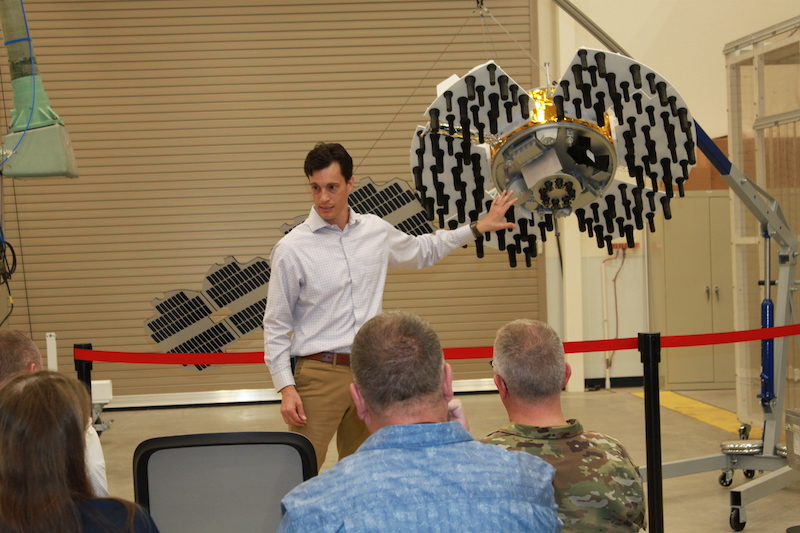The Navigation Technology Satellite-3, or NTS-3, is expected to change the architecture for satellite navigation and to deliver more robust PNT capabilities to warfighters. The experimental satellite will broadcast new signals from near-geosynchronous orbit (GEO), breaking the mold of how we currently view GPS and modernizing the service. The satellite recently just entered its next phase: preparation for a late 2023 launch.
Only four years after NTS-3 was announced as the U.S. Air Force’s first Vanguard program, the L3Harris space vehicle was recently delivered to an Air Force Research Laboratory (AFRL) test facility. The space vehicle is fully integrated and the PNT payload put together and assembled into the Northrop Grumman ESPAStar bus, with the team planning to start characterizing overall system performance this summer, NTS-3 Program Manager Arlen Biersgreen said.
This is a significant step forward as AFRL is now positioned to apply government and contractor resources to efficiently complete all the necessary steps before the satellite can be sent to Cape Canaveral for launch, Biersgreen said. This includes remaining intra-payload and payload-to-bus functional and performance tests. The first radio frequency broadcast tests of the novel PNT signals that will be demonstrated from GEO after the launch are among them—marking a huge milestone once achieved.
NTS-3 will provide a space platform for AFRL and partner organizations to conduct experiments and integrated capability demonstrations. The team is planning to experiment with techniques in line with what is now a more global community of GNSS, Biersgreen said.
“When GPS started 50 years ago it was the only game in town,” he said. “The picture of GNSS is different now than what it was then. You have other countries developing systems that are able to start with a blank slate and do things with the design of their system that are different though complement the way GPS works.”
The experiments
A team of about 30 scientists and engineers have been developing various tests since the program was launched, NTS-3 Principal Investigator Dr. Joanna Hinks said. From the beginning, their guiding philosophy has been to look at what they would want to do if they could design a system from scratch using the most modern technologies. One of the main goals is to develop a system that could be easily updated in-orbit without breaking, unlike past iterations, NTS-1 and NTS-2, that laid the groundwork for GPS but have remained largely unchanged.
The new satellite’s programable digital signal generator will make signals more resistant to interference, provide authentication against spoofing, or whatever the goal might be. It will be possible to upload a signal to the satellite and start transmitting it without having to relaunch the entire satellite, Hinks said, a huge and necessary advancement.
Another experiment involves the new phased array antenna. This feature makes it possible to digitally steer high powered beams and send signals where they’re needed so they can be optimally used on the ground, Hinks said.
The team is also exploring advanced time keeping to automatically detect when one of the atomic clocks has a glitch or anomaly and then correct for it so the satellite doesn’t have to be taken out of service to determine what went wrong, she said.
“Now that we have the satellite we can walk over and see it, so we’re already collecting a lot of data that will be used to inform our on-orbit experiments,” Hinks said. “We have the ability to actually touch things and change things, so we’re collecting data on the signals and clocks that’s being used to finalize the details of our experiment plan and help us understand how we need to collect data on-orbit.”
Preparing for Launch
This end-to-end integrated mission not only includes the satellite, but also the ground control system and reprogrammable user equipment, Biersgreen said. So beyond completing the remaining space environmental testing over the next nine months, including acoustic, shock and thermal vacuum testing and antenna calibration and characterization, the team also must train on a complex set of software tools that enable command and control as well as plan and execute more than 100 experiments.
It’s also critical to test the various interfaces, Hinks said, including the space craft interface to the user equipment and the ground control interface to the user equipment.
AFRL will depend on industry partners like L3Harris to deliver and fully support pieces of the ground control system. They’re also working to add automation to ground control. Common functions will be automated to eliminate the risk of introducing human error into repetitive tasks.
Advancing PNT for the Warfighter
The U.S. military and allies depend on GPS for 24/7 PNT timing data. It’s critical to them, Biersgreen said, and that’s why it has to be better.
“NTS-3 will explore technologies, techniques and new operational concepts to augment GPS from a geosynchronous orbit,” Biersgreen said. “We’re providing broadcasts from space designed to interact with GPS signals that will continue to be broadcast from MEO. We can further increase the robustness of GPS, which is part of the modernization effort.”
NTS-3 will provide increased resilience and flexibility to warfighters and others who rely on GPS, Biersgreen said. The satellite will be able to deliver signals in the most contested environments, providing reliable PNT services wherever soldiers are.
The satellite is breaking the mold of traditional GPS, Hinks said, showing it’s possible to provide a navigation service that looks different. It doesn’t have to be in MEO, with all the satellites in the same orbit, for instance. Different signals can be used in combination with legacy GPS signals for a more robust, flexible service.
“We’re opening up a safe space for future innovation,” Hinks said. “That augmentation, broadcasting something from GEO that’s complementary to what’s in MEO, that will be a big change, especially for military users who don’t have a cell network to get data from.”
Looking Ahead
There’s a lot happening with PNT, with the focus on finding different ways to get PNT data down to the user. NTS-3 is just one, Biersgreen said, but can serve as a pathfinder for “what will ultimately be a more complicated, multimode approach to satellite navigation services.”
NTS-3 is a demo satellite and not meant to have operational redundancy, Biersgreen said, but even when it does, it will have half the size, weight and power of the current GPS satellite, making it easier to launch.
“We’re also exploring options that will allow more than one satellite to be launched at once,” Biersgreen said. “That in itself really provides options that increase overall resilience of that systems of systems.”
The team is now working on integrating the ground control system and mission operations center at Kirkland Air Force Base in New Mexico. That will culminate this summer with the ground satellite capability test and team training.
The Global Navigation Satellite System Test Architecture (GNSSTA), a reprogrammable software-defined receiver that allows users to receive both legacy GPS and advanced signals generated by NTS-3, is also in development—and is of course critical. It lays the groundwork for future operational receivers to provide the Space Force with options to prevent and respond quickly to common battlefield threats, such as GPS jamming and spoofing.
“I don’t want to under emphasize the importance of making sure we have user equipment to receive the signals that are going to be broadcast,” Hinks said. “It’s ultimately the users who are going to get the benefit out of our navigation system. If we don’t have users, our satellite is just a big chunk of metal in the sky sending out signals to no one. We’re working with the AFRL Sensor Directorate and MITRE Corporation to develop a software-defined receiver, and they’re doing a fantastic job of showing the benefit of what we’re doing.”
NTS-3 is managed by the AFRL Transformational Capabilities Office in partnership with the U.S. Space Force and U.S. Air Force. NTS-3 will be launched aboard the new United Launch Alliance Vulcan rocket later this year at Cape Canaveral Space Force Station in Florida.




